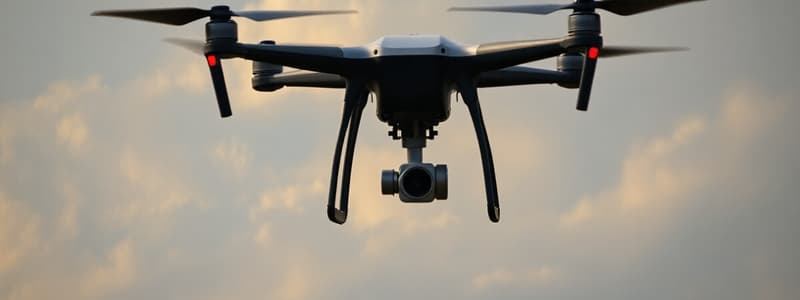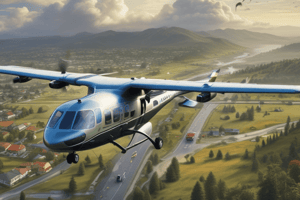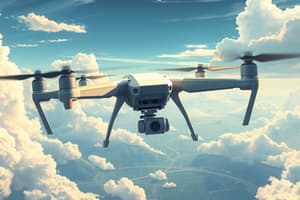Podcast
Questions and Answers
What is the maximum groundspeed allowed for a small unmanned aircraft system during operation?
What is the maximum groundspeed allowed for a small unmanned aircraft system during operation?
- 120 miles per hour
- 80 knots
- 100 miles per hour (correct)
- 87 knots (correct)
Under what condition can a small unmanned aircraft exceed an altitude of 400 feet?
Under what condition can a small unmanned aircraft exceed an altitude of 400 feet?
- When flown under 500 feet from clouds
- When it is within a 400-foot radius of a structure (correct)
- When it is flown at night
- When it is half a mile from the control station
What is the minimum flight visibility required when operating a small unmanned aircraft system?
What is the minimum flight visibility required when operating a small unmanned aircraft system?
- 5 statute miles
- 3 statute miles (correct)
- 1.5 statute miles
- 2 statute miles
What is the minimum distance that a small unmanned aircraft must maintain from clouds?
What is the minimum distance that a small unmanned aircraft must maintain from clouds?
Which statement is true regarding the operation of a small unmanned aircraft system with a transponder?
Which statement is true regarding the operation of a small unmanned aircraft system with a transponder?
What must a remote pilot in command complete before operating a small unmanned aircraft at night, as per the regulations?
What must a remote pilot in command complete before operating a small unmanned aircraft at night, as per the regulations?
What is the requirement for anti-collision lighting when operating a small unmanned aircraft system at night?
What is the requirement for anti-collision lighting when operating a small unmanned aircraft system at night?
During which periods is a small unmanned aircraft system prohibited from operation unless specific lighting requirements are met?
During which periods is a small unmanned aircraft system prohibited from operation unless specific lighting requirements are met?
Which of the following statements about civil twilight is correct?
Which of the following statements about civil twilight is correct?
What happens to certificates of waiver issued prior to March 16, 2021, for operating a small unmanned aircraft system at night?
What happens to certificates of waiver issued prior to March 16, 2021, for operating a small unmanned aircraft system at night?
What is one action a remote pilot in command can take regarding the intensity of the anti-collision lighting?
What is one action a remote pilot in command can take regarding the intensity of the anti-collision lighting?
Which section outlines the requirements for alcohol or drug use by those operating small unmanned aircraft systems?
Which section outlines the requirements for alcohol or drug use by those operating small unmanned aircraft systems?
What is the legal definition of civil twilight according to the outlined regulations?
What is the legal definition of civil twilight according to the outlined regulations?
What is one of the requirements that must be met if a visual observer is used during the operation of a small unmanned aircraft?
What is one of the requirements that must be met if a visual observer is used during the operation of a small unmanned aircraft?
Who is not allowed to manipulate flight controls of a small unmanned aircraft?
Who is not allowed to manipulate flight controls of a small unmanned aircraft?
What is the primary purpose of maintaining effective communication among the remote pilot, flight controller, and visual observer?
What is the primary purpose of maintaining effective communication among the remote pilot, flight controller, and visual observer?
What must a person operating a small unmanned aircraft do in Class B, Class C, or Class D airspace?
What must a person operating a small unmanned aircraft do in Class B, Class C, or Class D airspace?
Under which conditions is it permissible to operate a small unmanned aircraft over human beings?
Under which conditions is it permissible to operate a small unmanned aircraft over human beings?
What should the remote pilot assess before the flight of the small unmanned aircraft?
What should the remote pilot assess before the flight of the small unmanned aircraft?
How should the small unmanned aircraft interact with other airborne vehicles?
How should the small unmanned aircraft interact with other airborne vehicles?
What is the role of the remote pilot in command when utilizing a visual observer?
What is the role of the remote pilot in command when utilizing a visual observer?
What is one restriction placed on small unmanned aircraft regarding hazardous materials?
What is one restriction placed on small unmanned aircraft regarding hazardous materials?
What action should be taken if a small unmanned aircraft is proposed to operate in restricted airspace?
What action should be taken if a small unmanned aircraft is proposed to operate in restricted airspace?
What should not be done while operating multiple small unmanned aircraft at the same time?
What should not be done while operating multiple small unmanned aircraft at the same time?
What is a key responsibility of the remote pilot in command before flight?
What is a key responsibility of the remote pilot in command before flight?
What is one thing a remote pilot must ensure about any object carried by the small unmanned aircraft?
What is one thing a remote pilot must ensure about any object carried by the small unmanned aircraft?
What is the maximum altitude that a small unmanned aircraft can fly without special conditions?
What is the maximum altitude that a small unmanned aircraft can fly without special conditions?
What is the minimum visibility required for operating a small unmanned aircraft system?
What is the minimum visibility required for operating a small unmanned aircraft system?
What distance must be maintained from clouds when operating a small unmanned aircraft?
What distance must be maintained from clouds when operating a small unmanned aircraft?
What is the groundspeed limit when operating a small unmanned aircraft system?
What is the groundspeed limit when operating a small unmanned aircraft system?
What is prohibited regarding transponder equipment for small unmanned aircraft systems?
What is prohibited regarding transponder equipment for small unmanned aircraft systems?
What is the required visibility for anti-collision lighting when operating a small unmanned aircraft system at night?
What is the required visibility for anti-collision lighting when operating a small unmanned aircraft system at night?
What defines the period of civil twilight in areas outside of Alaska?
What defines the period of civil twilight in areas outside of Alaska?
Under what condition may the remote pilot in command reduce the intensity of the anti-collision lighting?
Under what condition may the remote pilot in command reduce the intensity of the anti-collision lighting?
What must a remote pilot in command complete before operating a small unmanned aircraft system at night?
What must a remote pilot in command complete before operating a small unmanned aircraft system at night?
What is the consequence for certificates of waiver issued prior to March 16, 2021, for night operations?
What is the consequence for certificates of waiver issued prior to March 16, 2021, for night operations?
What happens if a small unmanned aircraft system is operated during periods of civil twilight without proper lighting?
What happens if a small unmanned aircraft system is operated during periods of civil twilight without proper lighting?
What is the main purpose of the anti-collision lighting on a small unmanned aircraft system?
What is the main purpose of the anti-collision lighting on a small unmanned aircraft system?
What should remote pilots avoid while operating multiple small unmanned aircraft systems simultaneously?
What should remote pilots avoid while operating multiple small unmanned aircraft systems simultaneously?
What must the remote pilot in command ensure regarding the visibility of the unmanned aircraft throughout its flight?
What must the remote pilot in command ensure regarding the visibility of the unmanned aircraft throughout its flight?
What is NOT a responsibility of a visual observer during the operation of a small unmanned aircraft?
What is NOT a responsibility of a visual observer during the operation of a small unmanned aircraft?
What must a person manipulating flight controls NOT do regarding multiple small unmanned aircraft?
What must a person manipulating flight controls NOT do regarding multiple small unmanned aircraft?
Which statement correctly reflects the right-of-way rules for small unmanned aircraft?
Which statement correctly reflects the right-of-way rules for small unmanned aircraft?
Which condition allows a small unmanned aircraft to operate over human beings?
Which condition allows a small unmanned aircraft to operate over human beings?
What must be done before operating a small unmanned aircraft?
What must be done before operating a small unmanned aircraft?
What is required for operating a small unmanned aircraft in restricted areas?
What is required for operating a small unmanned aircraft in restricted areas?
What must the remote pilot do regarding communication with the visual observer?
What must the remote pilot do regarding communication with the visual observer?
Which of the following is a responsibility of the remote pilot in command prior to a flight?
Which of the following is a responsibility of the remote pilot in command prior to a flight?
Which statement about the carriage of hazardous materials by small unmanned aircraft is correct?
Which statement about the carriage of hazardous materials by small unmanned aircraft is correct?
How should a remote pilot assess the operation environment before flying?
How should a remote pilot assess the operation environment before flying?
What action is required regarding the small unmanned aircraft and its attachments?
What action is required regarding the small unmanned aircraft and its attachments?
What must a remote pilot do when operating in Class B, Class C, or Class D airspace?
What must a remote pilot do when operating in Class B, Class C, or Class D airspace?
What should a remote pilot do if a visual observer is utilized?
What should a remote pilot do if a visual observer is utilized?
Flashcards
Night Flight Rules for UAS
Night Flight Rules for UAS
Small unmanned aircraft systems (UAS) require specific lighting and training for night operations.
Lighting Requirements (Night)
Lighting Requirements (Night)
UAS must have anti-collision lights visible for at least 3 statute miles and sufficient flash rate to avoid collisions.
Civil Twilight Definition
Civil Twilight Definition
Time period either 30 minutes before/after sunrise/sunset (excepts Alaska, which uses Air Almanac).
UAS Night Operation Training
UAS Night Operation Training
Signup and view all the flashcards
Waiver Certificates (Night)
Waiver Certificates (Night)
Signup and view all the flashcards
Alcohol and Drugs for Remote Pilots
Alcohol and Drugs for Remote Pilots
Signup and view all the flashcards
Small UAS Groundspeed Limit
Small UAS Groundspeed Limit
Signup and view all the flashcards
Small UAS Altitude Limit
Small UAS Altitude Limit
Signup and view all the flashcards
Flight Visibility Requirement
Flight Visibility Requirement
Signup and view all the flashcards
Minimum Distance from Clouds
Minimum Distance from Clouds
Signup and view all the flashcards
Transponder Prohibition
Transponder Prohibition
Signup and view all the flashcards
Visual Observer Requirement
Visual Observer Requirement
Signup and view all the flashcards
Communication requirements (visual observer)
Communication requirements (visual observer)
Signup and view all the flashcards
Visual Observer's Duty
Visual Observer's Duty
Signup and view all the flashcards
Multiple Aircraft Operation Limitation
Multiple Aircraft Operation Limitation
Signup and view all the flashcards
Hazardous Material Prohibition
Hazardous Material Prohibition
Signup and view all the flashcards
Right-of-Way Rules
Right-of-Way Rules
Signup and view all the flashcards
Proximity to Other Aircraft
Proximity to Other Aircraft
Signup and view all the flashcards
Operation Over Humans
Operation Over Humans
Signup and view all the flashcards
Class B, C, D airspace restrictions
Class B, C, D airspace restrictions
Signup and view all the flashcards
Airport Operations Restrictions
Airport Operations Restrictions
Signup and view all the flashcards
Prohibited/Restricted Areas
Prohibited/Restricted Areas
Signup and view all the flashcards
Preflight Familiarization
Preflight Familiarization
Signup and view all the flashcards
Communication With Other Participants
Communication With Other Participants
Signup and view all the flashcards
Night UAS Operation
Night UAS Operation
Signup and view all the flashcards
Lighting Requirements (Night)
Lighting Requirements (Night)
Signup and view all the flashcards
Civil Twilight
Civil Twilight
Signup and view all the flashcards
UAS Night Operation Training
UAS Night Operation Training
Signup and view all the flashcards
Night Waiver Certificates
Night Waiver Certificates
Signup and view all the flashcards
Alcohol/Drugs (Remote Pilots)
Alcohol/Drugs (Remote Pilots)
Signup and view all the flashcards
Small UAS Ground Speed Limit
Small UAS Ground Speed Limit
Signup and view all the flashcards
Small UAS Altitude Limit
Small UAS Altitude Limit
Signup and view all the flashcards
Flight Visibility Requirement
Flight Visibility Requirement
Signup and view all the flashcards
Minimum Distance from Clouds
Minimum Distance from Clouds
Signup and view all the flashcards
Transponder Prohibition
Transponder Prohibition
Signup and view all the flashcards
Visual Observer Requirement
Visual Observer Requirement
Signup and view all the flashcards
Visual Observer Communication
Visual Observer Communication
Signup and view all the flashcards
Multiple Aircraft Operation
Multiple Aircraft Operation
Signup and view all the flashcards
Hazardous Materials
Hazardous Materials
Signup and view all the flashcards
Right-of-Way Rules
Right-of-Way Rules
Signup and view all the flashcards
Proximity to Other Aircraft
Proximity to Other Aircraft
Signup and view all the flashcards
Operation Over Humans
Operation Over Humans
Signup and view all the flashcards
Class B, C, D airspace
Class B, C, D airspace
Signup and view all the flashcards
Airport Operations
Airport Operations
Signup and view all the flashcards
Preflight Familiarization
Preflight Familiarization
Signup and view all the flashcards
Study Notes
Small Unmanned Aircraft System (UAS) Operating Rules
-
Alcohol or Drugs: Pilots manipulating UAS controls or acting as remote pilots/observers must follow FAA regulations 91.17 and 91.19.
-
Night Operation: Generally prohibited unless:
- Remote pilot has completed required training/testing after April 6, 2021.
- UAS has lighted anti-collision lighting visible for at least 3 miles with a flash rate to avoid collisions.
- Remote pilot can reduce lighting intensity if safety is improved.
- Civil twilight rules apply, varying by location (30 minutes before/after sunrise/sunset). Alaska has specific civil twilight definitions.
- Waivers issued before April 21, 2021 are no longer valid after May 17, 2021 for night operations.
-
Visual Line of Sight (VLOS) Operation:
- Pilot, observer (if applicable), and control operator must maintain continuous visual line of sight of the UAS throughout the flight. This is necessary for the pilot to maintain awareness of the following:
- Precise location of the aircraft
- Altitude, attitude, and direction of flight
- Surrounding airspace for hazards/other aircraft.
- Avoidance of endangerment to people/property.
- VLOS must be maintained by either the pilot and control operator or a designated visual observer.
- Effective communication must be maintained between all parties involved.
- The observer must be able to observe the UAS.
- The pilot and observer must coordinate to scan the airspace and maintain UAS awareness through direct observation.
- Pilot, observer (if applicable), and control operator must maintain continuous visual line of sight of the UAS throughout the flight. This is necessary for the pilot to maintain awareness of the following:
-
Multiple UAS Operation: Only one UAS can be operated at a time by one person.
-
Hazardous Materials: No hazardous materials are permitted on UAS.
-
Right-of-Way: UAS must yield to all aircraft, vehicles, and launch/reentry vehicles. Cannot fly over, under, or ahead of other craft unless well clear. Cannot operate UAS so close to other aircraft as to create risk.
-
Operation Over Humans: Allowed only in specific circumstances:
- Directly participating human in operation
- Human under a covered structure or a stationary vehicle providing sufficient protection
- Operation meets specific operational requirements for controlled operations in Subpart D.
-
Specific Airspace Restrictions: Operations in Class B, C, or D airspace or near Class E airport areas require explicit authorization from Air Traffic Control (ATC).
-
Airport Vicinity: UAS operation should never interfere with airport operations or traffic patterns.
-
Prohibited/Restricted Areas: Operations in these areas are forbidden unless permission is granted.
-
Notice to Airmen (NOTAM): Compliance necessary for flight restrictions.
-
Preflight Actions: Before flight, the pilot must assess risks, inform personnel, check control, power requirements, and security of attachments to the aircraft.
-
Operational Limitations:
- Maximum ground speed: 87 knots (100 mph).
- Maximum altitude: 400 feet AGL (above ground level) unless within 400 feet of a structure.
- Minimum flight visibility: 3 statute miles.
- Clouds: Maintain minimum distance of 500 feet below clouds and 2,000 feet horizontally from clouds
-
Transponder Prohibition: Generally, UAS cannot have a transponder activated unless specifically authorized by the governing body.
Studying That Suits You
Use AI to generate personalized quizzes and flashcards to suit your learning preferences.




